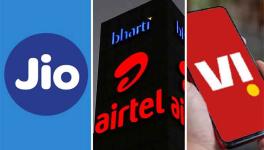So What is Jio's Business Model?
Image Courtesy: wikimedia.org
Reliance Jio has shaken the telecom market. Every day, we have news about other telecom companies dropping prices or losing share value in the stock exchange. Obviously, Jio is being seen as a game changer in telecom.
So what is Jio's business model in making voice calls free? For understanding its business model, we have to understand what revenue really is. Once the infrastructure is built, the running costs of a telecom network is low. A network therefore does not incur costs per call, or cost per data packet it transmits. Consequently, revenue is not the revenue per call or revenue per Gigabytes (GB) of data, but what the telecom company extracts from you as a consumer per month. Or in telecom language, the average revenue per user (ARPU). It is the monthly bill that you pay that really matters. This is what Jio is betting on.
Unlike other telecom companies, Jio does not have any existing voice customers; they lose nothing by offering free voice. In order to get free voice, the consumer will have to subscribe to a Jio data plan. As long as the average revenue per user remains high, Jio has no problem giving away voice free.
Looking at Jio's data plans, their ARPU – even for the lowest slab which is Rs. 149 for 28 days – is going to be higher than what the bulk of voice consumers today pay and almost the same as the ARPU of Vodafone, which has one of the highest ARPU – of Rs. 175 per month – among the existing telecom players.
Neither are the data plans much cheaper than the equivalent data plans of their competitors. If we convert them to equivalent monthly plans – apples to apples and not apple to peanuts -- we find that there are others are also offering similar data rates. For example, Anil Ambani's Reliance is offering data services – Rs. 500 for 5 GB as against Jio's Rs.499 for 4 GB -- that are actually cheaper than equivalent Jio plans.
For the existing telecom operators, about 70% of their income is from voice calls. If we consider them as data, the voice consumers are being charged 60 to 70 paisa per call minute, which should only be 2 paisa per minute in data terms.
Not surprisingly, the companies that still earn a huge part of their current revenue from voice are upset. They have had a good run, built their fortunes on gouging the voice consumers in India. When mobile telephony started in India, the initial rates were Rs. 16 and Rs. 10 per minute for making and receiving calls. I remember the huge battles we had in Telecom Regulatory Authority of India (TRAI) in trying to lower these outrageous charges. In one of the hearings I had asked why a mobile call should cost 48 times more than landline costs, when the cost per line for a mobile was one fifth that of a landline user? The TRAI saw their major task as helping the mobile operators in breaking the BSNL (Department of Telecom in those days) monopoly, and protected the mobile operators. They helped the Airtels, the Vodafones (or their ancestors) along with Cellular Operators Association of India (COAI), in gutting BSNL, paying as little as possible to BSNL as interconnecting charges, while the keeping call rates vey high for the consumers.
For a long time, despite a license, the government – then under the BJP – prevented BSNL and MTNL from entering the mobile market. It was BSNL's entry, Reliance promoting Limited Mobility by misusing their landline license, and consumer resistance that brought the first crack in this high price mobile regime. It was a combination of competition and consumer resistance that brought down the mobile elecom rates. India transitioned to a low cost mobile market by treating mobile telephony not as a value added service, but a basic telecom service.
The landline route for increasing teledensity has to contend with the very high cost of the network, particularly in sparsely populated areas. Mobile infrastructure can be deployed much faster, and at a much lower cost. This is what helped India to provide high connectivity or (teledensity) to its consumers.
In many countries, mobile is still treated as a premium, value added service and has high call rates. The mobile rates in most of Europe are still higher than their landline rates, and much higher than what we have achieved in the country. In most of the developing countries, it is switching to mobile networks and a low mobile price regime that has made possible improving teledensity. India is one of the first to have followed this route.
The existing telecom operators would have to rejig their operations quickly to meet the Jio threat. One route they have taken is denying Jio interconnections, leading to call failures when Jio subscribers call a person on a network other than Jio. The pretext is that as Jio is officially starting commercial operations from January 2017, they are required to provide only a few interconnections for testing purposes.
This may work for some time, but not for the long run. Once we accept that voice will now increasingly be treated as data -- whether it is Whatsapp or Jio -- the existing telecom players will have to generate more revenue from data services to compensate for their voice revenue loss. This demands that their data traffic increase dramatically, and a major scaling up of their networks. This is what they have not done. Instead, they have been relying on the very high revenue they earn from their existing voice services, treating data as a luxury. If we take the purchasing power of the people into account, the data charges in India are very high.
Is Jio a boon to the Indian telecom sector? Far from it. Reliance has a murky record of bending laws, if not breaking them
While Reliance did help break the mobile operators cartel, they also broke a number of laws. Some of them were criminal acts, carried out with full knowledge of the owners – Mukesh Ambani and Anil Ambani. Given their political and financial clout, they got away with a rap on the knuckles and some minimal fines.
The Comptroller and Auditor General (CAG) in its May report this year, has charged that Reliance Jio has been shown undue favours to the tune of Rs. 20,000 crore. While DoT has tried to defend itself on CAG's observations, it is difficult to see what defence there can be on some of the issues. Infotel Broadband paid Rs.12,847.77 crore, or 5,000 times its net worth of Rs. 2.5 crore for the BWA spectrum. After winning the bid, it was “acquired” by Mukesh Ambani Reliance and renamed as Reliance Jio. How can a company with net worth of Rs. 2.5 crore be allowed to bid, when the reserve price of the spectrum is in thousands of crores? This is a gross violation of bidding practices.
CAG has raised other issues as well: how can a Unified License be given in 2016 at a price discovered in 2001? If nothing else, should it not be adjusted with the price index or the value of a rupee then?
We need to separate the violations of Jio in securing licenses from the underlying telecom issue. Mobile telephony was indeed a technological revolution in telecom. The Jio plan is not built any such new technology. The telecom issue is the convergence between voice and data services and the challenge it poses for the regulatory regime. It is the regulatory regime that has now to address the technology change that has been around for quite some time.
Disclaimer: The views expressed here are the author's personal views, and do not necessarily represent the views of Newsclick
Get the latest reports & analysis with people's perspective on Protests, movements & deep analytical videos, discussions of the current affairs in your Telegram app. Subscribe to NewsClick's Telegram channel & get Real-Time updates on stories, as they get published on our website.























